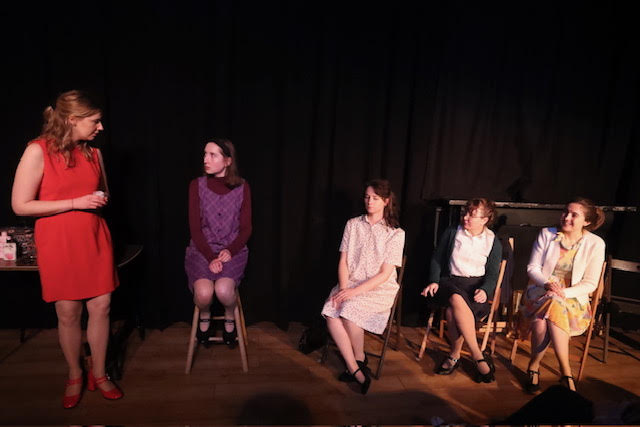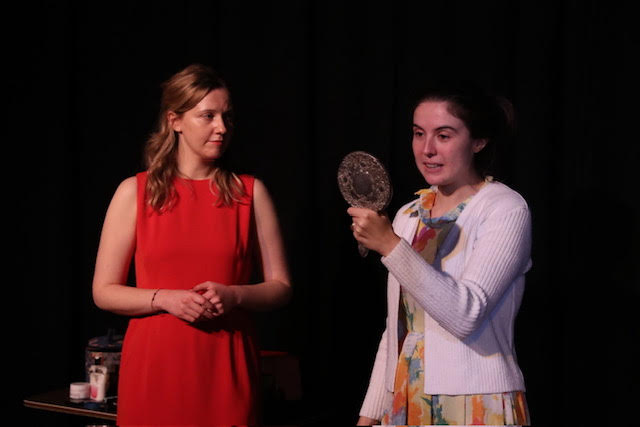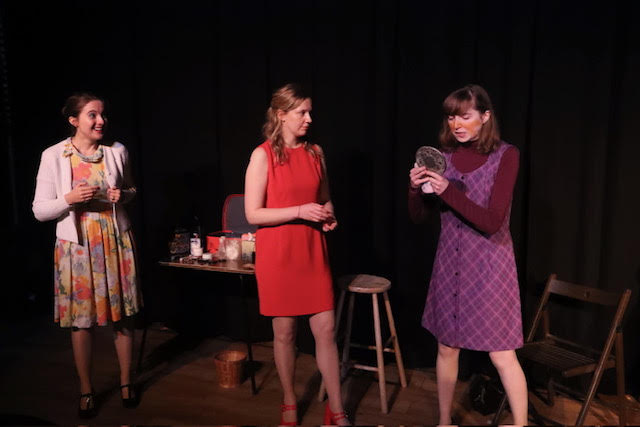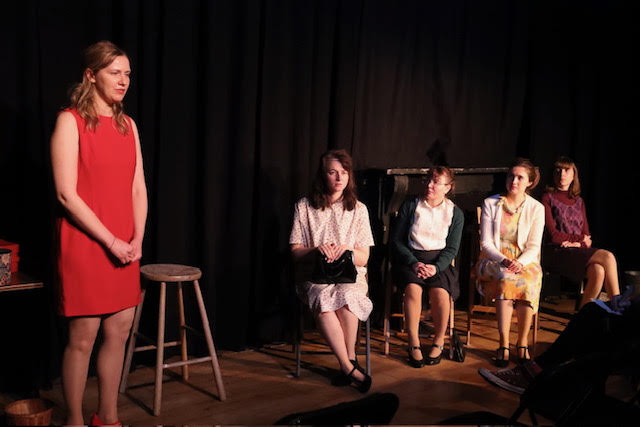The Revlon Girl
Information
- Date
- 13th November 2023
- Society
- Pranksters Theatre Company
- Venue
- The Star Inn, Guildford
- Type of Production
- Play
- Director
- Elizabeth Loveder
- Written By
- Neil Anthony Docking
Following the Aberfan tragedy of 1966, a group of young mothers came together to form a support group. The group soon had some 60 members and a waiting list. They arranged guest speakers on a variety of topics. At one point they organised a visit from a representative of Revlon to hopefully lift their spirits. They tried to keep this secret, so as not to be thought frivolous, as it was arranged just 8 months after the disaster.
The back room at Guildford’s Star Inn is an intimate venue, exactly right for a performance of this nature.
With its striking cover design of a well made-up yet tear-stained eye, the programme was very interesting. There was a piece on the disaster and on the Aberfan Young Wives club, plus useful links for those wanting more information. Moving photos of the cemetery with its rows of white grave arches taken by one of the cast were a great addition.
The play was performed set against a coal-grey curtain covering the rooms side wall. A few chairs, a table and a stool, plus a bucket to catch the copious amounts of water leaking through the roof, that was all. The Revlon girl had a smart case or two containing all her makeup.
Both lighting and sound were very effective throughout. We began, before the actors appeared, with the jolly sound of schoolchildren chatting and playing before the terrible rumble of the descending colliery spoil tip silenced them. The continuous loud falling rain accompanied the actors throughout the performance. Unrelenting rain, accompanied from time to time by ominous thunder, which emphasised the fear the villagers still felt about the remaining spoil tips.
Costumes were, for me, quite nostalgic. A pretty floral dress for Sian. A wide maternity dress, 1960s style, for Jean. A plain blouse, skirt and dull cardigan for Marilyn. Button through pinafore with toning pullover underneath for Rona. The Revlon girl looked suitably glamorous in a red 1960s style shift dress, and of course immaculate make-up.
This was a harrowing play. For me, I was instantly transported back to that time, I remember being at a wedding on the Saturday following the disaster, and finding it so odd, such a happy occasion when the whole of the country was devastated, and mourning the loss of those 116 children and 28 adults. As I watched the performance, I wondered about those around me in the audience who weren’t born at that time, did it affect them in the same way as it touched me, bringing back so many memories.
The Pranksters are to be congratulated on choosing this challenging quality drama for their autumn production, and Director Elizabeth Loveder for gathering together such a strong cast, who showed great commitment, skill and teamwork, and for her fine direction.
We first met the Revlon girl, who arrived in the allotted dingy room above the bar of presumably a pub, clutching her red case full of makeup. She already looked slightly uneasy in these foreboding surroundings. She was soon joined by cheery Sian, who greeted her warmly, yet seemed concerned on hearing that Revlon had parked in front of the building. At first I couldn’t understand why, but after everyone, as they arrived, also remarked on this, I soon twigged – nobody was supposed to know. So the poor girl was made to feel even more uncomfortable.
Next to arrive was Marilyn, who seemed exceptionally nervous, always on the point of leaving again. And yet she stayed. She was followed by angry Rona, who seemed to be in attack mode, she had a go at everyone, and nearly caused the Revlon girl to pack up her things and leave. Rona’s language was foul. Pregnant Jean, the vicar’s wife, appeared. She seemed calm and serene, quite a contrast to Rona.
Olivia Gorham was excellent as the Revlon girl. She in a way was playing us, the outsiders forced to deal with these grieving mothers, not knowing how to react in the face of this grief, which of course the mothers dealt with each in their different ways, as people do.
Caroline James gave a marvellous, believable performance as Sian, who dealt with her grief by putting on a cheerful face, and trying to chivvy along others. She was very good at dealing with reluctant Marilyn, and at generally keeping the peace. We discovered much later that Sian was desperate to have another child. Since the tragedy her husband had not been coping, and had not felt attracted to his wife any longer. Sian hoped that paying more attention to her appearance might turn that around. Caroline James excelled herself in this role, her desperation was palpable, quite unforgettable.
Marilyn was very sweetly played by Alex Gold. Here was a young woman completely lacking in confidence, and totally bereft at the loss of her two girls. She felt that there had been warnings about the disaster, indeed she carried around with her a picture her daughter had drawn, where Marilyn felt she had had a premonition. She was a superstitious soul, which puzzled the others, and made Rona very angry.
Jean, the vicar’s wife, was able of course to find her solace, together with her husband, in religion, and hoped to persuade others to do the same. Another strong performance, this time from Emily Rawlinson. Jean was guilty, we found out, of considering her surviving daughter a ‘second best’, having lost her beloved first-born son, and she could find no joy in her pregnancy.
Rona exploded onto this rather tranquil scene with gusto, anger spilling out of every pore. She set upon poor docile Marilyn, and constantly demanded her last cigarette. The Revlon girl also bore the brunt of her anger, with her flashy car, cushy job, and – as she thought – cushy life. Alice Gray made a fine job of being Rona, we all became very aware of the injustice of the tragedy, the culpability of the Coal Board. Marilyn also helped in this, I believe. Rona’s irritation with the other ladies, although of course unjust, was very understandable.
In her frustration at being attacked so by Rona, at being accused of being shallow and superficial, the Revlon girl finally revealed her own tragedy, the loss of her brother, the rejection of her, the surviving child, by her mother. (Watching Jean’s face was interesting here). She ‘saved’ her mother, enabled her to pick up her life again, by the simple act of helping to put on her lipstick. ‘You see, it’s not JUST lipstick’, she said. How true, ‘putting your face on’ is about facing the world, returning to a kind of normality. A strong, believable performance by Olivia Gorham.
Five cracking performances then, bringing out all the nuances in this great writing. I can’t say I ‘enjoyed’ this play, but I certainly did really appreciate it, the way it confronted us with having to deal with the ways in which people deal with grief. It is a play that stays with you.
 |
 |
 |
 |
© NODA CIO. All rights reserved.

 Show Reports
The Revlon Girl
Show Reports
The Revlon Girl